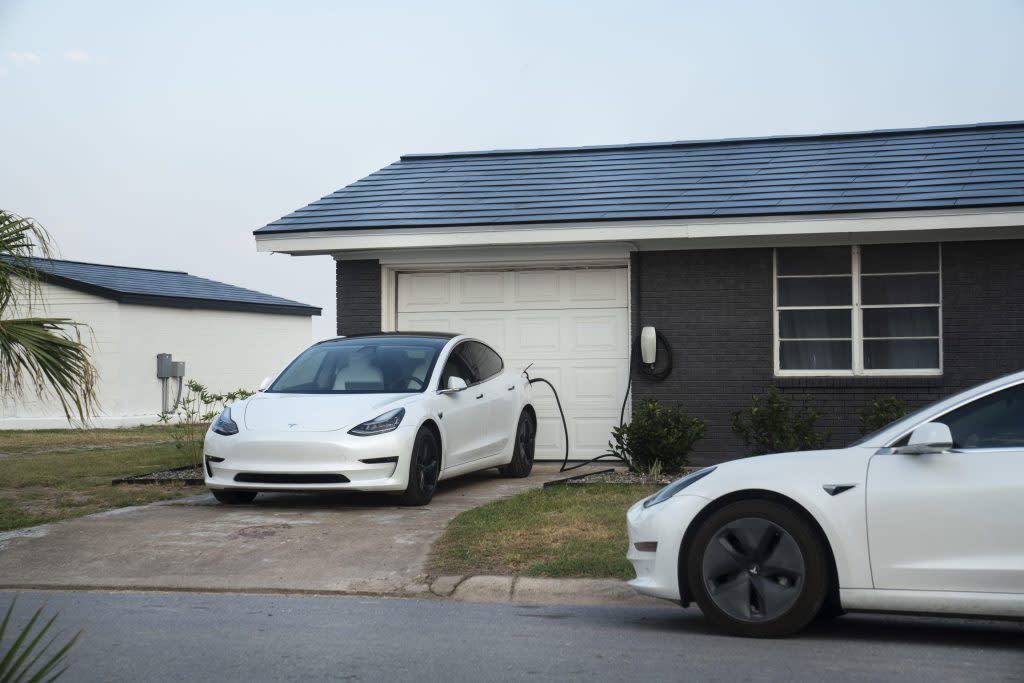How Elon Musk’s solar ambitions fell back to earth
For an entrepreneur who thrives on loud and splashy promotion, it’s hard to imagine a more forlorn spot than Tesla’s upstate New York “Gigafactory 2.” Built on the former grounds of a steel mill, the 1.2-million-square-foot complex, which Tesla leases from the taxpayer, was supposed to be the largest facility of its kind in the entire Western hemisphere, capable of producing 1,000 megawatts of solar roofs and panels annually once fully scaled. The massive RiverBend site would then serve as a beacon to other entrepreneurs, attracting more advanced manufacturing jobs to the area.
Some seven years later the lights are still on—but just barely. Wood Mackenzie estimated aggregate Tesla Solar Roof installations in the U.S. just recently hit 3,000 since the product launched—not even enough to produce a measly 30 megawatts of electricity in total. For context, Musk had aspired to a goal of installing 1,000 roofs per week. While the solar market grows, deployments of all Tesla solar products barely eked out a 1% increase in the past year, deploying 348 MW of capacity—and so far in 2023 it is tracking toward an annual decline of nearly a third. The bulk of its business remains selling conventional photovoltaic (PV) solar panels, where it lacks a unique selling point or first mover edge.
Solar Roof and standard panel production at its Gigafactory 2 in upstate New York now remains so low that Tesla had to hire low-level IT analysts inputting data for self-driving cars, says Sean Ryan, a state senator representing the Buffalo area, just to hit employment targets imposed as conditions for receiving state aid.

Around 1,500 jobs needed to be created at the site lest Tesla be subject to fines in the tens of millions of dollars. “They limped over the finish line and only with a lot of help,” Ryan tells Fortune. (Tesla did not respond to a request for comment.)
Unveiled in 2016, these elegant and durable tiles made from a specially treated tempered glass serve as both shingles and solar cells. They can withstand the impact of golf-ball-size hail, snap in and out for easy replacement if needed, and come with a 25-year warranty. Paired with a Tesla Powerwall residential battery, homeowners can marvel at all the energy they generate and store using the company’s smartphone app. In short, it’s the ultimate early adopter product for the energy-independent household.
“We have customers that send us screenshots of their apps for months after we install them,” raves Matthew Jaynes, senior vice president of residential and solar at KPost Roofing in Dallas.
Indeed, the Tesla Solar Roof may very well earn the distinction of being Musk’s most under-hyped product—as well as one he appears to have little interest in selling.

The holy trinity of clean energy
The unveiling of Tesla’s Solar Roof coincided precisely with the brand’s entry into the market seven years ago through the $2.6 billion acquisition of SolarCity, founded by two of Musk’s cousins, Lyndon and Peter Rive. At the time it was the U.S. market leader with just over 800 MW installed in 2016, more than twice what Tesla achieved last year. Yet controversy dogged the deal. Facing a “major liquidity crisis,” SolarCity was in dire straits by the end of 2015 and risked breaching loan covenants. A class action lawsuit led by Arkansas’s teachers pension fund argued that Musk, as the largest shareholder of both companies with roughly a fifth of the voting stock, stood to profit directly from the acquisition and used his influence to strong-arm Tesla’s board into a bailout. While the directors settled out of court, Musk fought the claims and won in Delaware’s chancery court last year. The state supreme court later affirmed the ruling.
Nowadays SolarCity’s assets are folded into Tesla where they constitute only a minor part of its energy generation and storage segment, answerable to Drew Baglino, the longest serving of Musk’s top three lieutenants. The Tesla senior vice president’s immediate priority is improving the performance of his next-gen 4680 battery cells and scaling their production for Musk’s core automotive segment; fixing solar is likely very far down on Baglino’s to-do list. How many of Tesla’s 128,000 employees work for its solar business is anyone’s guess, since the company publishes only a quarterly deployment figure to keep investors apprised of its progress. Chances are, however, it’s not much more than a rounding error.

In theory, solar completes Musk’s virtuous circle of clean energy products—a holy trinity where Tesla customers own an EV, plug the car into their household battery to recharge, and power everything with the warm bountiful glow of the sun’s rays.
“We don’t sell a lot of Tesla Solar Roofs to people that don’t already have an electric vehicle,” KPost’s Jaynes confirms. “They tend to already be on the bandwagon and are looking at how to go to the next level.”
Musk has often predicted his $3.9 billion energy operations will eventually grow to rival in size and profitability its much larger autos business, which generated $67 billion in revenue and a gross margin in the high 20s last year. Yet while its Megapack commercial battery storage business outperforms investor expectations, solar specifically remains so insignificant that most investors don’t even bother trying to model its results, according to Gary Black, cofounder and managing partner of the Future Fund and a well-known Tesla bull. “It is the next frontier of sustainability, because you can use your Solar Roof to charge your car,” he says. “But it’s a much tougher business since a lot of it is installation. And it’s harder to differentiate yourself than in EVs, where Tesla has a first mover advantage.”

The solar market is heating up
Thanks to a 30% federal income tax credit, soaring energy prices, and often generous feed-in tariffs for selling excess power to utilities, the U.S. residential solar market enjoyed its sixth consecutive record year in 2022, and some 700,000 homeowners had a photovoltaic roof installed, equating to a grand total of six gigawatts—a 40% annual increase in production capacity, according to Wood Mackenzie and the Solar Energy Industries Association. More important, it’s not just the U.S. experiencing strong demand. The International Energy Agency argues solar PV will overtake coal by 2027 to become the largest source of power generation in the world now that costs have dropped more than 80% in the past decade.
Some critics (and competitors) think that Musk miscalculated in trying to use the Tesla blueprint at SolarCity—before realizing how different the two businesses are.
“If you think about what might be the opposite of the centralized production lines at Tesla’s streamlined car business, it would be providing custom-made solar roofs where you have to measure everything to the inch to fit perfectly,” says Svea Solar cofounder Erik Martinson. “There’s no synergies whatsoever.”
The native Swede and Tesla Model 3 driver was inspired by Musk during his time living in San Diego and says he applied five separate times to work for the carmaker—receiving a rejection every single time.
Solar remains so insignificant most investors don’t bother trying to model its results.
Gary Black, managing partner, the Future Fund
Instead Martinson cofounded his own solar energy company and claims it already surpassed his role model’s current average run-rate of 60 MW of solar PV capacity per quarter. “This year we’re doing about 75 megawatts per quarter, but we’re growing quite rapidly, so next year we will increase that to over 100 megawatts,” he says. In his view, Tesla’s solar business might very well grow faster were it a stand-alone company.
Musk has already tried to course correct after realizing that—unlike the over 1 million virtually identical Model Y cars stamped out in cookie-cutter fashion this year—installing solar PVs to fit each and every need required reinventing the wheel each time. “We basically made some significant mistakes in assessing the difficulty of certain roofs,” Musk conceded back in April 2021, opting to try to standardize the approach so that in future, each customer’s house “looks the same electrically instead of being a unique work of art.”
And persuading homeowners to take the leap into solar isn’t an easy sell, even in places like Texas that have a shaky and unreliable power grid. A lot of that has to do with the premium price that can easily run to $50,000 for a Solar Roof with an average 10 kilowatt array including stationary battery. Far too many Texans move every few years to make such an investment pay off, Jaynes said. And spreading the word is difficult given that Musk is extremely skeptical of advertising. His last big push for media attention came all the way back in October 2016 when he first presented the Solar Roof, a few short weeks before Tesla shareholders were due to vote on his SolarCity acquisition.
And in recent years, shareholders have seemed far more keen on his endeavors in artificial intelligence, self-driving cars, and two-legged Optimus droids. By comparison Musk’s third Master Plan, which included a pitch for more solar, landed with a thud on Investor Day in March. How can craftsmen clambering up on rooftops to install panels compete for attention next to the eventual promise of robot butlers? During all three of its 2023 quarterly earnings calls, the subject of Tesla’s solar business was broached only once—by Baglino. With volumes trending in the wrong direction, Musk himself understandably had little appetite and avoided the issue entirely.
Back in upstate New York, the Gigafactory 2 sputters on, just barely. Tesla’s industrial partner in the project, Panasonic, has already pulled out of the site, eliminating hundreds of jobs in the process. Some $200 million worth of machinery bought by state taxpayers has since been sold off or simply scrapped.
“The resurrection of that site was deeply symbolic,” Ryan said. “We pinned a lot of hopes and a good deal of economic development funds on this one project, which turned out to be a failed silver bullet. Now we feel deflated.”
This story was originally featured on Fortune.com
